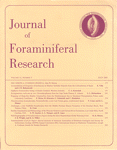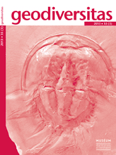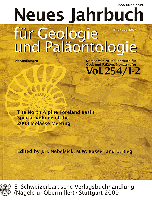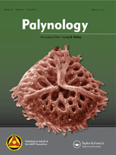
JOURNAL OF FORAMINIFERAL RESEARCH
Scope & Guideline
Championing Scholarly Discourse in Foraminiferal Studies
Introduction
Aims and Scopes
- Taxonomy and Systematics:
Research on the classification, description, and evolutionary relationships of foraminiferal species, including the introduction of new species and revisions of existing taxa. - Paleoecology and Biostratigraphy:
Studies that investigate the ecological roles of foraminifera in ancient environments, their distribution patterns in geological strata, and their utility in biostratigraphic frameworks. - Environmental Indicators:
Utilization of foraminiferal assemblages as bioindicators for reconstructing past environmental conditions, including climate change impacts, sea-level changes, and pollution effects. - Morphological and Geochemical Analysis:
Research focusing on the morphological characteristics of foraminiferal tests and their geochemical signatures, contributing to understanding species adaptations and ecological dynamics. - Modern and Fossil Foraminiferal Studies:
A dual focus on contemporary foraminiferal communities and fossil records to draw connections between past and present ecological systems.
Trending and Emerging
- Climate Change and Foraminiferal Responses:
An increasing number of studies are exploring how foraminiferal communities respond to climate change, particularly in the context of ocean acidification, temperature fluctuations, and sea-level rise. - Technological Advances in Foraminiferal Research:
The integration of advanced techniques such as isotopic analysis, molecular methods, and high-resolution imaging is on the rise, enhancing the understanding of foraminiferal biology and ecology. - Interdisciplinary Approaches:
Emerging research often combines foraminiferal studies with other disciplines such as geology, ecology, and climate science, reflecting a trend toward holistic environmental assessments. - Benthic Foraminifera as Ecological Indicators:
There is a growing focus on using benthic foraminiferal assemblages to assess ecosystem health and monitor environmental changes, particularly in coastal and estuarine habitats. - Foraminifera in Relation to Marine Biodiversity:
Research examining the role of foraminifera in marine biodiversity and their contributions to ecosystem functioning is becoming more prominent, highlighting their ecological significance.
Declining or Waning
- Freshwater Foraminifera:
Research on freshwater foraminifera has seen a decrease, possibly due to a shift in focus towards marine environments and the ecological significance of marine foraminifera. - In-depth Taxonomic Reviews:
While taxonomic studies remain important, the frequency of comprehensive reviews on previously described species is declining, possibly due to the increasing number of new species being identified. - Foraminifera in Extreme Environments:
Studies focusing on foraminiferal communities in extreme environments, such as deep-sea vents or hypersaline conditions, are less frequently published, indicating a shift towards more mainstream ecological studies.
Similar Journals

CRETACEOUS RESEARCH
Exploring Fossils and Evolutionary MysteriesCRETACEOUS RESEARCH, published by Academic Press Ltd - Elsevier Science Ltd, is a leading journal in the field of Paleontology that has established itself as an essential resource for researchers and professionals delving into the rich tapestry of the Cretaceous period. With its ISSN 0195-6671 and E-ISSN 1095-998X, this journal boasts a prestigious placement in the academic landscape, holding a Q1 rank in the 2023 Paleontology category and proudly positioned at 21st out of 113 in the Scopus ranking, reflecting its impact factor that places it in the 81st percentile. Since its inception in 1980, CRETACEOUS RESEARCH has facilitated a deeper understanding of prehistoric life and its evolutionary processes, covering topics such as fossil discoveries, paleoecology, and biostratigraphy. This journal best serves those seeking to expand their knowledge and contribute innovative findings to the scientific discourse surrounding the Cretaceous era. As it continues to converge into the future until 2025, it remains dedicated to providing an open platform for the dissemination of high-quality research that shapes our understanding of Earth’s geological past.

BULLETIN OF GEOSCIENCES
Unveiling the Secrets of Earth’s Processes and EnvironmentsBULLETIN OF GEOSCIENCES, published by the prestigious Czech Geological Survey, stands as a pivotal resource in the fields of Earth and Planetary Sciences and Environmental Science. Since its inception in 2003, the journal has been committed to advancing knowledge through high-quality research, currently holding a commendable Q2 ranking in both disciplines. With its focus on diverse and innovative topics, BULLETIN OF GEOSCIENCES provides an essential platform for researchers, professionals, and students aiming to disseminate and access impactful studies. The journal is indexed in Scopus, ranking #78/195 in General Earth and Planetary Sciences and #110/233 in General Environmental Science, reflecting its significant contribution to academia. Publishing from Prague, Czech Republic, this journal invites contributions that illuminate the interactions between geological processes and environmental phenomena, ensuring an inclusive and accessible approach to crucial global issues.

PALEOBIOLOGY
Pioneering Research in the Evolution of LifePALEOBIOLOGY, published by Cambridge University Press, is a premier, peer-reviewed journal that stands at the forefront of research in paleontological sciences. With a robust commitment to advancing the study of the interactions between ancient life forms and their environments, the journal has established itself as a vital resource for researchers, professionals, and students in the fields of paleontology, ecology, and evolutionary biology. Spanning from 1975 to 2024, it boasts an impressive Q1 ranking in several categories, including Agricultural and Biological Sciences, Ecology, and Paleontology, indicative of its high impact and relevance in shaping contemporary scientific discourse. While the journal is not open access, it offers a variety of subscription and access options, ensuring broad distribution and visibility of published research. As a leader in its discipline, PALEOBIOLOGY aims to facilitate a deeper understanding of our planet's biological history, making it an essential publication for anyone interested in the dynamics of life across geological time.

GEODIVERSITAS
Bridging the Past and Present in Earth SciencesGEODIVERSITAS, an esteemed journal published by the Museum National d'Histoire Naturelle, represents a significant contribution to the fields of geology and paleontology. With an ISSN of 1280-9659, this peer-reviewed publication has established itself as a vital resource for researchers, professionals, and students alike, disseminating high-quality and innovative research since its inception in 2002. Covering a broad spectrum of topics within earth sciences, GEODIVERSITAS not only showcases cutting-edge studies but also fosters a deeper understanding of geological and paleontological phenomena. Ranked in the Q2 category of both geology and paleontology for 2023, the journal exemplifies rigorous scholarly standards and makes significant strides in enhancing knowledge within these disciplines. With its headquarters in Paris and a commitment to scientific excellence, GEODIVERSITAS stands as a leading voice in contemporary earth science research, inviting contributions that drive forward the conversation in geology and paleontology.

Gondwana Research
Pioneering Insights into Earth's Ancient SupercontinentGondwana Research is a premier academic journal published by Elsevier, specializing in the field of geology, with a robust focus on the geological history and processes of the Gondwana supercontinent. With an impressive impact factor and ranking as Q1 in the 2023 Geology category, it stands as a leading platform for disseminating high-quality research. The journal features articles that advance the understanding of Earth and planetary sciences, making significant contributions to geological education and research. Researchers will find its curated content particularly valuable, as it encompasses a wide array of topics including stratigraphy, paleontology, and tectonics, all relevant to both contemporary and historical geological inquiries. Given its substantial reach and esteemed standing—ranked 5th out of 321 in its field—Gondwana Research plays a crucial role in fostering scientific exchange among global experts. Located in the United States with publication continuity from 1997 to 2024, this journal consistently attracts submissions from leading scientists, ensuring that its readership is kept at the forefront of geological discovery and innovation.

NEUES JAHRBUCH FUR GEOLOGIE UND PALAONTOLOGIE-ABHANDLUNGEN
Charting New Territories in Paleontological ResearchNEUES JAHRBUCH FUR GEOLOGIE UND PALAONTOLOGIE-ABHANDLUNGEN, published by E SCHWEIZERBARTSCHE VERLAGSBUCHHANDLUNG, is a distinguished scholarly journal based in Germany that has made significant contributions to the field of Earth and Planetary Sciences with a particular emphasis on Paleontology. With its ISSN: 0077-7749, this journal provides an essential platform for researchers, professionals, and students to explore cutting-edge research and developments that enhance our understanding of geological and paleontological processes. Boasting a robust ranking of #67 out of 113 in Scopus for the category of Earth and Planetary Sciences and achieving a Q3 quartile ranking in Paleontology, it stands as a significant resource in the global academic community. Though not an open-access journal, it offers valuable insights from 1987 onwards, ensuring a comprehensive archive of high-quality research articles published from 1995 to 2024. Its scholarly impact continues to resonate, making it a vital reference point for advancements in the ever-evolving disciplines of geology and paleontology.

PALYNOLOGY
Charting the Evolution of Life Through Fossilized EvidencePALYNOLOGY, published by Taylor & Francis Inc in the United Kingdom, is a prominent academic journal focused on the field of paleontology, particularly the study of fossilized pollen and spores. Established in 1977, this journal continues to thrive, with comprehensive coverage of significant advancements and research findings in palynology, highlighting its integral role in understanding past ecosystems, climate changes, and evolutionary processes. With an impressive Scopus ranking of #34 out of 113 in the Earth and Planetary Sciences category, and a notable Q2 classification, PALYNOLOGY serves as a vital resource for researchers, professionals, and students committed to deepening their knowledge of paleontological studies. Although currently not Open Access, the journal remains dedicated to delivering valuable insights and fostering scholarly communication in the field, making it an essential read for anyone invested in the complexities of Earth’s biological history.

Earth and Environmental Science Transactions of the Royal Society of Edinburgh
Championing excellence in Earth and environmental research.Earth and Environmental Science Transactions of the Royal Society of Edinburgh is a prestigious journal published by Cambridge University Press, dedicated to advancing research in the field of Earth and planetary sciences, as well as environmental science. With its ISSN 1755-6910 and E-ISSN 1755-6929, the journal has established itself as a crucial platform for disseminating innovative research and comprehensive reviews since its inception in 2007. Positioned in the Q3 quartile for both Earth and Planetary Sciences and Environmental Science, it contributes significantly to the ongoing dialogue and development in these areas, boasting a Scopus ranking that reflects its commitment to scholarly excellence with an emphasis on interdisciplinary approaches and real-world applications. The journal is based in the United Kingdom, with its editorial office located at the Edinburgh Building, Shaftesbury Road, Cambridge. As an essential resource for researchers, professionals, and students alike, Earth and Environmental Science Transactions offers opportunities for open discourse on pressing environmental challenges, fortifying its role in fostering a deeper understanding of our planet's systems and their interconnectedness.

Swiss Journal of Palaeontology
Bridging Science and History in PaleontologySwiss Journal of Palaeontology, published by SPRINGER INT PUBL AG, stands as a leading platform for innovative research within the field of paleontology, contributing significantly to the understanding of Earth's historical life forms and their evolutionary pathways. With its ISSN 1664-2376 and E-ISSN 1664-2384, this journal has established a strong presence in academic circles, recognized as a Q1 journal in the category of Paleontology for 2023. Moreover, it ranks 20th out of 113 in the Earth and Planetary Sciences, securing an impressive 82nd percentile on Scopus, underscoring its influence and reach in the scientific community. The journal publishes cutting-edge research findings, theoretical advancements, and comprehensive reviews that span the globe, making it an essential resource for researchers, professionals, and students in the paleontological sciences. For those interested in contributing to and learning from the latest discoveries, the Swiss Journal of Palaeontology promises to be an invaluable addition to your academic library.

NAUTILUS
Advancing Aquatic Sciences for a Sustainable FutureNAUTILUS is a distinguished journal published by the Bailey-Matthews Shell Museum, dedicated to advancing the understanding of aquatic sciences as well as ecology, evolution, behavior, and systematics. With an ISSN of 0028-1344, NAUTILUS has played a significant role in the scholarly community from its inception, with publication converged between 1996 to 2015 and 2017 to 2024. Although currently categorized as Q4 in Aquatic Science and Ecology, Evolution, Behavior and Systematics for 2023, the journal has a reputation for publishing high-quality research that contributes to the broader scientific discourse. Researchers and students alike can benefit from the insights provided by NAUTILUS, which remains committed to exploring the intricate relationships within aquatic ecosystems. Its editorial management, led by Dr. José H. Leal, ensures rigorous peer review and academic excellence, making it a crucial resource for those dedicated to discovering the complexities of aquatic and ecological research.